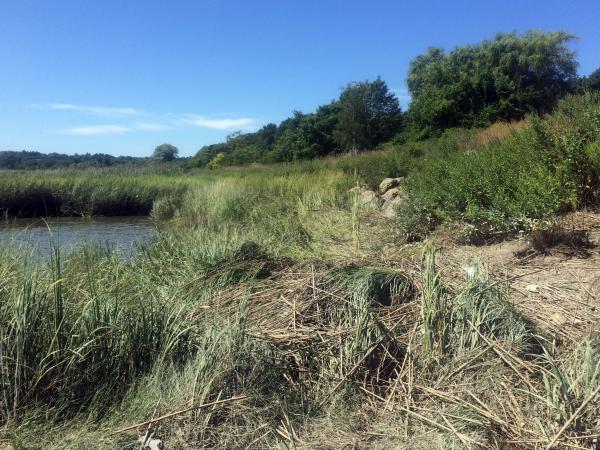August 25, 2016

"Water levels along the Neponset are still high downstream, but the marsh grass is vulnerable." Cole Rosengren photo
As boats float by and local residents fish for stripers it may not be obvious what’s happening on the Neponset River. Yet officials’ warnings are unequivocal: A drought is here and it is a serious problem.
Boston is experiencing its driest summer in nearly 60 years, with just 3.03 inches of rainfall recorded between June 1 and Aug. 21, far below the norm of almost 8 inches over the two months. The drought has caused streams throughout the state to dry up and has led to lower water levels for rivers such as the Neponset. The full effects of what has recently been classified as an “extreme drought” in the region are still unknown, but some things are already clear.
“Environmentally, you’re going to see a loss of habitat for wildlife,” said Meghan Rauber, field sampling coordinator for the Neponset River Watershed Association (NRWA). “Obviously, fish have nowhere to go if a river bed dries up.”
Rauber said that some tributaries are now dry and water flow throughout the Neponset is low this year. While this may be less noticeable downstream toward the harbor, the low flow can still affect the many fish, turtles, frogs, ducks and other wildlife that live throughout the river. “There are very likely spots like that in Dorchester that we don’t sample but are dry right now,” she added.
The NRWA has predicted that parts of the river might dry up completely by the end of this summer for the first time in 40 years. In addition to the effects this will have on wildlife, the dry-out will also pose a challenge to the 120,000 people who rely on the Neponset Watershed for their water supply.
According to the most recent US Drought Monitor data, 64 percent of the state is currently experiencing a “severe drought” and nearly 17 percent is in a worse state, an “extreme drought.” Secretary of Energy and Environmental Affairs Matthew Beaton issued a drought warning for the region earlier this month, but some say the state’s response was too slow based on signs given by low precipitation throughout the year.
“It’s something that should have been anticipated and the state could have done a better job at preparing people for this,” said Julia Blatt, executive director of the Massachusetts River Alliance. “At that point you’ve missed an opportunity to get people to get conserve water.”
Blatt’s organization led 45 environmental groups to send a letter to Beaton earlier this month calling for an overhaul of the state’s Drought Management Plan and more public education on water usage.
Boston’s water supply is not currently a concern and the city hasn’t issued any water restrictions. Yet last week, Governor Charlie Baker encouraged all state residents to be mindful of their water usage by taking shorter showers and not watering their lawns or washing their cars.
In the short term, Massachusetts is focused on mitigating the drought’s effects on water supply and agriculture, although some say it would be wise to start planning for what’s ahead. Drought conditions are a common occurrence in many parts of the country and could happen again here. “Climate change experts are predicting that we will have more droughts, they will be more severe, and they will be of longer duration in the future,” said Blatt.
One place to look for resiliency strategies is the Southeast section of the country, which has experienced three severe droughts in the past 17 years.
Christine Angelini, a native New Englander who is an assistant professor of environmental engineering at the University of Florida, recently published a study in the journal Nature Communications on potential recovery methods in salt marshes. “We’re always working on this issue in a reactive way,” she said, noting the importance of monitoring salinity levels in marshes before they get too high.
Angelini and her collaborating researchers found that mussels can play a key role in making marshes more resilient. Small patches of remaining grass can also help drastically reduce the recovery time after a drought by in a sense healing the marsh from within. Although the soil composition in New England is different from that in the Southeast, Angelini said these methods could be promising for the Neponset’s salt marshes and cautioned that this may not be the last summer of its kind.
“If this is an unprecedented drought event for your region, anticipate another one to come in short order,” she cautioned.


